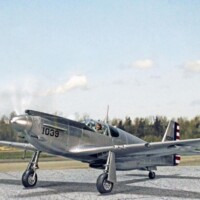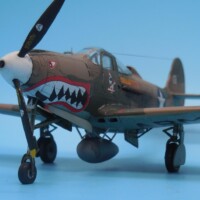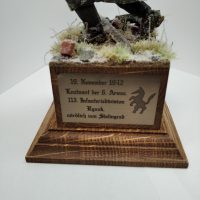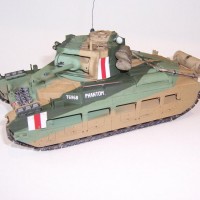Zveno-1A
Here’s my latest project, the Zveno-1A from A-Model in 1:72. Not an easy build. The two I-5 fighters were built first. The instructions consisted of an exploded view with lines showing the approximate locations of parts. Fortunately, I built a Special Hobby I-5 in 1:48 some time back, so I used it as a guide and got the fighters to look something like I-5s. Then on to the TB-1. The instructions were a little more clear, most of the major parts fit without too much trouble. The exception was the cockpit, engines, and guns with all their fiddly little pieces. The painting instructions called for “light green, light blue”, etc. I used Model Master Russian Underside Blue and MRP AMT-4 green on the fighters and Mr. Color Russian Green 1 mixed with a little Russian Green 2 for a little contrast between the fighters and the bomber, as different manufacturers likely had differences in colors, and some factories used whatever they had available. The decals went on OK. I’m happy to be done with this one!
In the 1930s when the U.S, Navy was launching and recovering parasite fighters such as the Curtiss F9C Sparrowhawk from their rigid airships USS Macon and USS Akron, the Soviets were experimenting with carrying parasite Fighters aboard Tupolev TB-1 and TB-3 bombers with the Zveno Project (Проект «Звено»). It was the brainchild of the aviation engineer Vladimir Vakhmistrov, consisting of a twin-engined Tupolev TB-1 bomber with a Tupolev I-4 sesquiplane fighter carried above each wing. The first flight was made on December 3, 1931. The sesquiplanes eventually had their bottom wings removed and became parasols, with no loss of performance. This configuration was known as Zveno-1. It was followed up with Zveno-1A with the I-4s replaced with the more capable Polikarpov I-5 fighters (the subject of this build). The fighters were rolled aboard the wings via ramps at the trailing edge and secured to the wings at 3 points on the fuselage and main landing gear legs, the thrust line of the fighters aligned with the thrust line of the mother ship. The fighters were manned during all operations with their engines running. The idea was that the combined thrust of the fighters and the bombers engines would more than compensate for the added weight during takeoff and during flight to assist the mother ship which proved quite successful, and the fighters supported their own weight while in flight The pilots in the fighters detached by unlocking the fuselage attach point, then releasing the landing gear locking mechanisms by pulling back on the control stick.
Further Zveno projects utilized the larger 4-engine TB-3, initially with three I-5 fighters, one on each wing and one atop the fuselage. The center I-5 was hoisted up onto the fuselage by hand and was found to be cumbersome. At some point the wings and tail were removed from the center fighter and it was used as a fifth engine only.
Later developments had 2 Polikarpov I-5s on top of the wings and 2 Polikarpov I-16s under the wings with the gear retracted for ground clearance. Other experiments were conducted with a retractable trapeze arrangement under the fuselage where a Gregorovich I-Z fighter (a fixed gear monoplane fighter similar to the P-26) made the first ever docking in flight between two fixed wing aircraft on March 23, 1935. Later, two I-16s docked and undocked with a retractable trapeze under each wing. While this was possible, it was deemed too difficult to be practical.
Still further developments gave birth to the “Aviamatka” (Airborne Mothership). A TB-3 with two I-5s on top of the wings and two I-16s under the wings took off and a Gregorovich I-Z docked under the fuselage in flight. The first flight occurred on November 20, 1939. The next Aviamatka experiment involved a TB-3 with eight I-16s. The TB-3 would take off with two I-16s under the wings, and the remaining six would dock one at a time, refuel, and undock, making room for the next. Although a few docking, refueling, and undocking flights were successfully completed in 1938, the eight fighter idea was soon abandoned.
In 1938 Vakhmistrov conceived the “Zveno-SPB (Sostavnoi Pikiruyuschiy Bombardirovschik) combined dive bomber project which involved a TB-3 mothership and two I-16s under the wings, each armed with a pair of 250kg FAB-250 high explosive bombs. Once the I-16s dropped their bombs they reverted back to their fighter role. The SPB test program successfully concluded in 1938 and an order was placed for 20 SPB TB-3s and 40 I-16 Type 5 fighters for the air force, with a similar number for the navy. However, by 1939 the government’s enthusiasm for the project waned, and the navy cancelled their order and the air force order was reduced from 40 to 12 fighters.
By the time the war started in 1939 Soviet military observers noted the success of the Stuka dive bombers. Because the Soviets had no dive bombers, it was decided to revive the Zveno-SPB project with the more powerful I-16 Type 24 fighters. Six combinations were built and assigned to the 2nd Special Squadron of the 32nd Fighter Regiment of the 62nd Aviation Brigade of the Black Sea Air Force. Based in Western Crimea under the command of Arseny Shubikov, the unit became known as “Shubikov’s Circus”. The unit was soon tasked for attacking industrial targets in Nazi allied Romania, specifically the Constanta oil depot and the King Carol I bridge over the Danube. On July 25, 1941 two Zveno units released their bomb-laden I-16s which attacked the oil depot with no losses and returned to their base in Crimea. On August 10, 1941 Three Zveno-SPB flights with the I-16s fitted with additional underwing fuel tanks allowing them an additional 30 minutes of flight time departed their base in Crimea to attack the King Carol bridge. One TB-3 had to abort due to mechanical problems, and the other two launched their fighters 10 miles from the Romanian coastline and successfully bombed the bridge from 6,000 feet and returned to base with no losses despite heavy anti-aircraft fire. The second raid on the bridge occurred on August 13. Three Zveno-SPB units arrived over the target and five of the six fighters scored direct hits on the bridge which destroyed one of the spans, followed by strafing Romanian infantry units near Sulina on their return to base, again with no losses.
Following the successful raids, two more Zveno-SPB units became operational, bringing the total to five. On August 16 Admiral Nikolai Kuznetsov asked for some TB-3s from the Air Force to be converted to Zveno-SPB carriers, but the request was denied as the TB-3 units suffered heavy losses during the early days of the war and due to a shortage of the Mikulin AM-34FRN engines for the TB-3. During the rest of August, the Air Force made several more Zveno raids on Romanian targets.
In spite of the successes of the Zveno raids, the missions ended in late 1941 because the TB-3s were becoming obsolete and vulnerable in the face of superior numbers and quality of enemy fighters. The Zveno-SPB units flew about 30 combat missions.






















Great work on a really interesting subject.
Thank you, Dale.
Excellent work! Thanks for sharing your experience. I have one of those taunting me from the stash.
Thanks, John. This one will keep you busy for awhile!
Excellent model and a very interesting article. A Model kits do need work but with skill produce superb models.
Thank you, Christopher. This is my first A-model. I've had worse kits.
Now that's very cool. Great job and a great subject.
I'd love one in 1/48.
Thanks, Paul. Yeah, I'd like a TB-3 in 1:48!
That is really interesting Chas. Excellent work throughout and a really amazing result.
Thanks, Tom.
Excellent model of a very unique subject!
Thank you, Robert.
G’day Chas (@chasbunch),
This is a great model of a bit of history.
Of course, the end of WW2 didn’t see the end of the idea with the US experimenting with XF-85 Goblin and F-84 Thunderjet ‘parasite’ fighters.
Very well executed.
Liked!
Thanks, Michael. Yeah, better equipment and better technology. It makes the early efforts seem kind of crude, but somebody had to try it first.
Inspiring work, Chas.
Thank you, Rafi.
Fantastic result of a very interesting but rarely seen subject, Chas!
Well done!
Thank you, Spiros.
Excellent work on this unique concept, Chas @chasbunch
Thanks for sharing the history behind it.
Thanks, John.
Hats off to your modelling skills, with which you have transformed a difficult A-model kit into a very realistic representation of this special piece of aviation history. The pictures you took of the finished model are very good and look almost real.
I also really liked the quite detailed historical part of your article, as I didn't realise that the Zveno was actually operational in WWII, albeit with a limited number of sorties. Just a small historical note: at the time of the Zveno bombings, Romania was not occupied by the Nazis, but was an ally of the Nazis.
Thank you, Peter. Yes, there's a big difference between being occupied and being an ally. I had to edit my post.
Awesome looking model(s)! Always like the Zveno concept - such a crazy idea!
Thank you, Sebastian.
Great looking builds, Chas! Extremely interesting subject.
Thank you, Gary.
Nuthin' to say but WOW on this one. Always thought the TB's were tres cool looking aeroplanes. Very well executed project.
Thanks, Bill.
Wow - that's one heckofa project! Looks really good - well done!
Thank you, Greg.
Nicely done Chas, different, well presented.
Thanks, Allan.